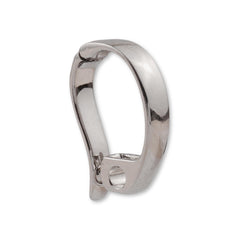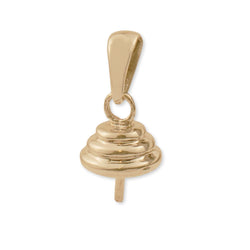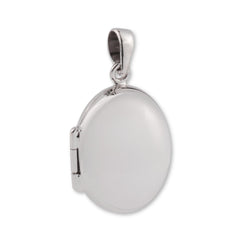Necklace Findings
Necklace & Pendant Findings Australia
Our Pendant Fittings collection is an essential resource for both professional jewellers and DIY enthusiasts. We offer a diverse selection of high-quality findings, meticulously crafted to meet the demands of modern jewellery making. Whether you are designing a delicate necklace, a statement pendant, or a personalised bracelet, our collection provides the perfect components to bring your vision to life. Explore our range of pendant fittings, each made from precious metals including sterling silver, 9ct, and 18ct gold, to ensure your creations are not only beautiful but also durable.
Versatility and Quality in Every Piece
From the elegance of our Bails to the functionality of our End Caps, our findings are designed to offer versatility and precision in your jewellery designs. Our Enhancer Pendants and Pearl Cup Pendant Settings allow for easy customization, making them ideal for those who want to add a unique touch to their jewellery pieces. These fittings are more than just accessories; they are the building blocks of timeless jewellery, crafted to enhance the beauty and longevity of your designs.
Ethical Jewellery Making with Recycled Metals
We are committed to promoting ethical jewellery practices, which is why our pendant fittings are made from a combination of newly mined and recycled metals. By choosing ethically sourced sterling silver, yellow gold, rose gold, and white gold, you contribute to sustainable jewellery making that minimises environmental impact. Our collection supports the growing demand for ethical and eco-friendly jewellery, ensuring that your creations are both stylish and responsible.
A Wide Range of Applications
Our pendant fittings collection is suitable for a wide range of jewellery-making projects. Whether you are creating elegant lockets, classic pearl pendants, or intricate enhancer pendants, our findings provide the ideal solution. The compatibility of these fittings with various necklace chains, cords, and bracelets ensures that you can design pieces that are both cohesive and visually stunning. Each component is crafted to meet the highest standards of quality, ensuring that your jewellery remains secure and beautiful over time.
Customizable Components for Unique Designs
We understand that every jewellery piece is unique, which is why our collection includes customizable components such as bails and pendant settings. These fittings can be adjusted to match the specific needs of your design, allowing you to create bespoke pieces that reflect your personal style or your client's preferences. Pair these findings with our range of chains and clasps to create a complete, polished look that exudes professionalism.
Enhance Your Creations with Professional-Grade Findings
Our pendant fittings are designed to enhance the overall quality and appeal of your jewellery. Whether you are working with pearls, gemstones, or metalwork, our findings provide a secure and elegant finish that elevates your designs. Explore our collection of bails, enhancer pendants, pearl cup pendant settings, and more, all crafted to support your creative vision and ensure that your jewellery stands out in both craftsmanship and style.
Frequently Asked Questions
- Bails: These are connectors used to attach pendants to a necklace chain or cord. They come in various shapes and sizes and can range from simple loops to more decorative styles.
- Enhancers: Similar to bails but often with a clasp mechanism, enhancers allow for pendants to be easily added or changed on a necklace. They're ideal for versatility and can be used with a variety of necklace styles.
- Pearl Cup Pendants: These are specialized settings designed to hold pearls or round beads. They have a cupped base with a peg to secure the pearl in place.
- Lockets: Lockets are a type of pendant that can open to reveal a space inside for keeping photos or other small keepsakes. They come in various designs, from classic to contemporary.
- End Caps: Used in finishing the ends of necklaces, with a variety of styles depending on whether your finishing cord or metal chain. End caps provide a neat and professional finish to the jewellery piece.
- Pendant Settings: These are the parts of a necklace that hold a gemstone, crystal, or other decorative elements. They come in various forms, like prong settings, bezel settings, or snap-in settings, allowing versatility depending on the style and type of stone being set.
These findings are essential for creating a range of necklace styles and designs, allowing for customization and personalization in jewellery making.
Depending on the desired style and aesthetic you're after, here's a list of all the components you could need:
- Chain or Cord: This is the main structure of the necklace, which can vary in length, material, and style. Options include metal chains, leather cords, or synthetic materials.
- Clasp: The mechanism used to open and close the necklace. Common types include lobster clasps, spring ring clasps, toggle clasps, and magnetic clasps.
- Jump Rings: Small metal rings used to attach the clasp to the chain or cord and often used to add other components to the necklace.
- Pendants or Charms: Decorative elements that hang from the necklace. They can be attached directly to the chain or through other findings like bails.
- Bails: Connectors that allow you to attach a pendant or charm to the chain, providing a way for it to hang properly.
- Enhancers: Clasp-like components that allow you to add or interchange pendants on a necklace more easily.
- Beads and Spacer Beads: Used to add decoration and style to the necklace. Spacer beads are specifically used to separate other beads or components evenly.
- Wire, String, or Beading Thread: Depending on the type of necklace, you might need flexible beading wire, nylon thread, or other stringing materials.
- End Caps: Used to finish the ends of corded or multi-strand necklaces, providing a neat and secure closure.
- Pendant Settings: If your design includes setting stones or crystals, you'll need pendant settings like bezel settings, prong settings, etc.
- Tools: Basic jewellery-making tools such as pliers (needle nose, round nose, flat nose), wire cutters, and possibly a crimping tool.
- Bails: Attach or solder the bail to the pendant, then slide it onto your chain or cord. Bails provide an easy way to add or interchange pendants on a necklace.
- Enhancers: These can be clipped onto a chain or cord, allowing you to add or change pendants without needing to slide them over the end of the necklace.
- Pearl Cup Pendants: Insert the pearl or bead onto the peg of the pearl cup pendant, securing it in place, often with adhesive.
- Lockets: Can be attached directly to the chain or through a bail. They open to hold small keepsakes or photos.
- End Caps: Used for finishing the ends of multi-strand or corded necklaces. Secure them with solder, glue or by crimping, depending on their design.
- Pendant Settings: Set your chosen stone or decorative element into the setting. This might involve snapping the element into place or using a setting technique like prong or bezel setting.
Pendant fittings are components used to attach pendants or charms to necklaces, bracelets, or earrings. They provide a secure connection between the jewellery piece and the chain or cord. Pendant fittings come in various styles, including bails, bezel settings, and prong settings, allowing you to showcase gemstones, pearls, or other decorative elements in your designs.
Choosing the right pendant fitting depends on the style, size, and weight of the pendant, as well as the type of chain or cord used. For heavy pendants, opt for sturdy bails like snap lock or pinch bails. If you’re setting a gemstone, consider using bezel or claw settings for a secure fit. For a minimalist look, choose a simple bail or loop fitting that complements the pendant’s design.
Using recycled metals in jewellery making helps reduce the environmental impact by minimizing the need for new mining. Recycled metals, such as recycled sterling silver or gold, maintain the same quality and durability as newly mined metals, making them an ethical choice for jewellery makers. Additionally, consumers increasingly prefer eco-friendly and sustainable products, which can enhance the appeal of your jewellery designs.
Essential tools for working with pendant fittings include jeweller’s pliers, tweezers, a magnifying glass, and a jeweller’s loupe. For setting gemstones, you’ll need a prong pusher or bezel roller, depending on the setting type. A fine-tipped glue applicator is useful for glue-on fittings, while a polishing cloth helps maintain the finish of your fittings.
To care for and maintain jewellery with sterling silver fittings, store the pieces in a cool, dry place, preferably in anti-tarnish pouches or a jewellery box. Clean sterling silver regularly with a soft polishing cloth to remove tarnish and restore shine. Avoid exposing silver jewellery to harsh chemicals, moisture, and prolonged sunlight to prevent tarnishing.
Yes, pendant fittings can be used in both modern and vintage-inspired designs. Modern designs often feature sleek, minimalistic fittings like simple bails or bezel settings. For vintage-inspired designs, consider using ornate, detailed bails or settings that echo antique styles. The choice of metal finish, such as aged silver or rose gold, can also enhance the vintage look.
To create a layered necklace design, choose pendant fittings of varying lengths and styles that complement each other. Start with a central focal pendant on a longer chain and layer additional pendants on shorter chains. Mix different shapes, sizes, and metal finishes to add depth and interest to the design. Ensure the chains have different textures and thicknesses to avoid tangling.
Yes, pendant fittings can be customized for bespoke jewellery pieces. Many jewellers offer custom fittings tailored to the specific design, gemstone size, and metal preferences of the client. Custom fittings allow for greater creativity and personalization, ensuring that the final piece is unique and perfectly suited to the wearer’s taste.
To achieve a professional finish in your jewellery designs, focus on precision and attention to detail. Use high-quality materials and tools, ensure all connections are secure, and take care to avoid scratches or blemishes on the metal. Polishing the final piece to a high shine and ensuring that all elements are aligned and symmetrical will contribute to a polished, professional look.
Yes, pendant fittings are suitable for beginners in jewellery making. Many pendant fittings, such as glue-on bails or simple loop fittings, are easy to use and require minimal tools or expertise. Beginners can start with basic projects using these fittings and gradually progress to more complex designs as they gain experience and confidence.
When selecting components for a jewellery project, consider the style, durability, and compatibility of the materials. Ensure the metal types match or complement each other, and choose components that suit the design’s aesthetic, whether modern, vintage, or minimalist. Also, consider the wearer's preferences, such as metal allergies, and the overall functionality of the piece.
To prevent tarnish on sterling silver jewellery findings, store them in a dry, airtight container, preferably with anti-tarnish strips. Regularly clean the findings with a soft polishing cloth to remove any surface oxidation. Avoid exposing the silver to chemicals, moisture, and prolonged sunlight, as these can accelerate tarnishing.
To mix and match different metals in a jewellery design, choose metals that complement each other, such as gold and silver, or rose gold and platinum. Use a unifying element, such as consistent shapes or textures, to tie the design together. Balance the use of each metal to create a cohesive look, and ensure that the different metals are in harmony with the overall style.
For a minimalist jewellery design, choose simple, understated fittings that do not overpower the piece. Opt for sleek bails, small bezel settings, or discreet loops that allow the focus to remain on the pendant or gemstone. The use of clean lines, polished finishes, and neutral metal tones like silver or white gold can enhance the minimalist aesthetic.
To securely attach a pearl cup pendant to a necklace, first, mount the pearl onto the peg of the cup using jewellery adhesive. Ensure the pearl is firmly set and allow the adhesive to cure fully. Once the pearl is secure, attach the pendant to the necklace chain using a bail or jump ring, making sure the connection is tight and secure.
To set a gemstone in a claw pendant setting, place the stone into the setting and gently push the prongs over the stone using a prong pusher or jeweller's pliers. Ensure that the prongs are evenly spaced and securely hold the stone in place. Check that the stone is level and adjust the prongs as needed to ensure a secure and professional finish.
Yes, pearl cup pendants can be used with gemstones other than pearls, provided the gemstone is drilled to fit the peg of the cup. Gemstones like opals, turquoise, and other soft stones work well with pearl cup settings. Ensure the gemstone is securely mounted with adhesive and that it fits snugly onto the peg.
Bezel cup pendant settings offer several advantages for cabochons. They provide a secure and protective setting that holds the stone in place, preventing it from falling out. Bezel settings also create a smooth, polished edge around the cabochon, enhancing its appearance and giving the jewellery a sleek, finished look.
When choosing a bail for a heavy pendant, opt for a sturdy, durable bail such as a snap lock or pinch bail. These types of bails provide a secure connection and can support the weight of the pendant without risk of breaking or detaching. Ensure the bail size matches the thickness of the chain or cord and that it complements the pendant’s design.
Yes, enhancer pendants can be used to convert charms into pendants. The hinge or loop mechanism of an enhancer pendant allows it to easily attach to a charm, turning it into a pendant that can be worn on a necklace. This versatility makes enhancer pendants a popular choice for creating interchangeable jewellery pieces.
A pearl cup setting is designed specifically for mounting drilled pearls or round gemstones by fitting the stone onto a peg within the cup. In contrast, a bezel setting encircles the entire gemstone, securing it within a metal rim. Bezel settings are typically used for cabochons or flat-back stones, while pearl cups are ideal for round, drilled stones like pearls.






